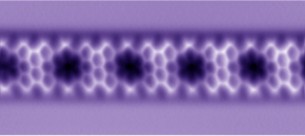Boron-doping of graphene nanoribbons

Researchers have succeeded in synthesising boron-doped graphene nanoribbons and characterising their structural, electronic and chemical properties.
The modified material, developed by the physicists at the University of Basel, could potentially be used as a sensor for the ecologically damaging nitrogen oxides. Their findings have been reported in the latest issue of Nature Communications.
Graphene is one of the most promising materials for improving electronic devices. The two-dimensional carbon sheet exhibits high electron mobility and accordingly has excellent conductivity. Other than usual semiconductors, the material lacks the so-called band gap, an energy range in a solid where no electron states can exist. Therefore, it avoids a situation in which the device is electronically switched off. However, in order to fabricate efficient electronic switches from graphene, it is necessary that the material can be switched ‘on’ and ‘off’.
The solution to this problem lies in trimming the graphene sheet to a ribbon-like shape, named graphene nanoribbon (GNR). Thereby it can be altered to have a band gap whose value is dependent on the width of the shape.
To tune the band gap in order for the graphene nanoribbons to act like a well-established silicon semiconductor, the ribbons are being doped. To that end, the researchers intentionally introduce impurities into pure material for the purpose of modulating its electrical properties. While nitrogen doping has been realised, boron-doping has remained unexplored. Subsequently, the electronic and chemical properties have stayed unclear thus far.
Prof. Dr Ernst Meyer and Dr Shigeki Kawai from the Department of Physics at the University of Basel, assisted by researchers from Japanese and Finnish Universities, have succeeded in synthesising boron-doped graphene nanoribbons with various widths. They used an on-surface chemical reaction with a newly synthesised precursor molecule on an atomically clean gold surface. The chemical structures were directly resolved by atomic force microscopy at low temperature.
The doped site of the boron atom was unambiguously confirmed and its doping ratio — the number of boron atoms relative to the total number of atoms within the nanoribbon — lay at 4.8 atomic percent. By dosing nitric oxide gas, the chemical property known as the Lewis acidity could also be confirmed.
The doped nitric oxide gas was highly selectively adsorbed on the boron site. This measurement indicates that the boron-doped graphene nanoribbon can be used for an ultrahigh sensitive gas sensor for nitrogen oxides which are currently a hot topic in the industry as being highly damaging to the environment.
Light reshapes semiconductors for advanced optical devices
Researchers have shown how light reshapes Janus semiconductors at the atomic scale, enabling...
Novel method to grow ultrathin semiconductors on electronics
Researchers have developed a technique that could speed up the development of next-generation...
Blue LEDs developed to enhance display performance
Researchers have developed a new method for manufacturing light-emitting diodes (LEDs) that emit...




